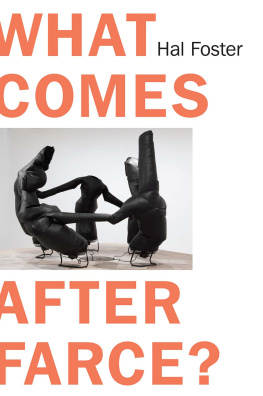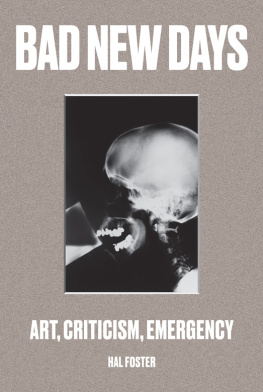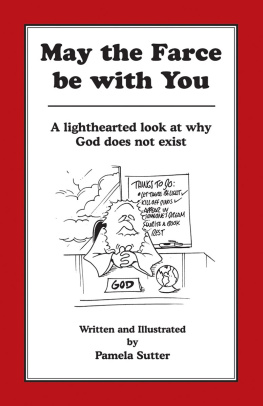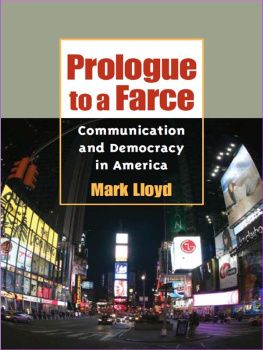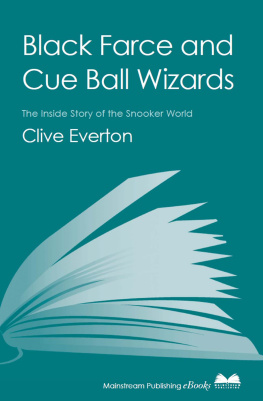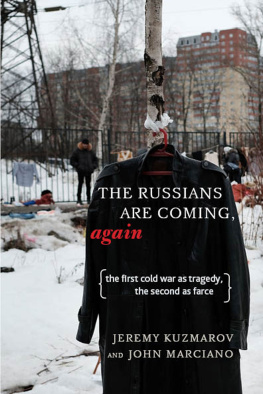Contents

What Comes after Farce?
What Comes after Farce?
Art and Criticism at
a Time of Debacle
Hal Foster

First published by Verso 2020
Hal Foster 2020
All rights reserved
The moral rights of the author have been asserted
1 3 5 7 9 10 8 6 4 2
Verso
UK: 6 Meard Street, London W1F 0EG
US: 20 Jay Street, Suite 1010, Brooklyn, NY 11201
versobooks.com
Verso is the imprint of New Left Books
ISBN-13: 978-1-78873-811-8
ISBN-13: 978-1-78873-812-5 (UK EBK)
ISBN-13: 978-1-78873-813-2 (US EBK)
British Library Cataloguing in Publication Data
A catalogue record for this book is available from the British Library
Library of Congress Cataloging-in-Publication Data
Names: Foster, Hal, author.
Title: What comes after farce? : Art and criticism at a time of debacle / Hal Foster.
Description: London ; New York : Verso, 2020. | Includes bibliographical references and index. | Summary: If farce follows tragedy, what follows farce? Where does the double predicament of a post-truth and post-shame politics leave artists and critics on the Left? How to demystify a hegemonic order that dismisses its own contradictions? How to belittle a political elite that cannot be embarrassed, or to mock party leaders who thrive on the absurd? How to out-dada President Ubu? And, in any event, why add outrage to a media economy that thrives on the same? What Comes After Farce? comments on shifts in art, criticism, and fiction in the face of the current regime of war, surveillance, extreme inequality, and media disruption. A first section focuses on the cultural politics of emergency since 9/11, including the use and abuse of trauma, paranoia, and kitsch. A second group reviews the neoliberal makeover of art institutions during the same period. Finally, a third section surveys transformations in media as reflected in recent art, film, and fiction. Among the phenomena explored here are machine vision (images produced by machines for other machines without a human interface), operational images (images that do not represent the world so much as intervene in it), and the algorithmic scripting of information so pervasive in our everyday lives--Provided by publisher.
Identifiers: LCCN 2019038482 (print) | LCCN 2019038483 (ebook) | ISBN 9781788738118 | ISBN 9781788738125 (UK ebk) | ISBN 9781788738132 (US ebk)
Subjects: LCSH: Arts--Political aspects--History--21st century. | Arts and society--History--21st century.
Classification: LCC NX180.P64 F67 2020 (print) | LCC NX180.P64 (ebook) | DDC 701/.03--dc23
LC record available at https://lccn.loc.gov/2019038482
LC ebook record available at https://lccn.loc.gov/2019038483
Typeset in Sabon by MJ & N Gavan, Truro, Cornwall
Printed and bound by CPI Group (UK) Ltd, Croydon CR0 4YY
Contents
Marx made the notion sound already like a clich when he first presented it in The Eighteenth Brumaire of Louis Bonaparte (1852): Hegel remarks somewhere that all great world-historic facts and personages appear, so to speak, twice. He forgot to add: the first time as tragedy, the second time as farce. The tragedy was the seizing of dictatorial power by Napoleon in 1799, and the farce was the repeating of this act by his nephew Napoleon III in 1851. How could the Bonaparte clan get away with the same power grab twice? Although it seemed that nothing was learned in the repetition, this was not the case according to Marx, for it did clarify an essential point: that the bourgeoisie was only too ready to ditch its democratic valueslibert, galit, fraternitif doing so meant that it could retain its economic domination. Alarmed by the 1848 revolution, the ruling class acceded to another emperor, a copy more ridiculous than the original.
In our time, Donald Trump has performed a similar clarification: apparently, many American plutocrats regard the trashing of constitutional laws, the scapegoating of immigrants, and the mobilizing of white supremacists as a small price to pay for even more capital concentration through financial deregulation, tax cuts, and corrupt deal-making. And, like the lumpenproletariat in France then, millions in the United States today have succumbed to the fascist virus, which promises to protect them from such exploitation even as it delivers them all the more completely to it.
If farce follows tragedy, what follows farce? Along with a modicum of clarity has come a lot of bullshit. As the
I take up these questions and many others in the short texts gathered here. Drafted over the last fifteen years, a period punctuated by the financial crisis of 2008 and the perpetual catastrophe that is Trump, these bulletins comment on shifts in art, criticism, and fiction in the face of the current regime of war, terror, and surveillance, as well as of extreme inequality, climate disaster, and media disruption. algorithmic scripting of information that is so pervasive in our everyday lives.
If all this sounds dire, it is. In many respects we look out on a world that has moved, not only politically but also technologically, beyond our control. And this extreme situation has prompted extreme formulations by artists and critics alike. Thus, for example, Trevor Paglen sees art as a safe house in the invisible digital sphere, while Claire Fontaine imagines it as a human strike against all scripted identities, even as Hito Steyerl declares that, since subjectivity is colonized by capitalism, we might as well identify with objects.
The pattern of tragedy followed by farce is still a logic of sorts: history retains a narrative even if it is a bathetic one. Yet perhaps this coherence was an illusion, and, again, what could come after farce anyway? Nothing necessarily. Palliatives like the moral arc of the universe bends toward justice or we must strive for a more perfect union of the nation hardly soothe anyone anymore. Nothing is guaranteed; everything is a struggle. Again locally, it is no longer clear whether art can depend on its own past, and its present seems institutionally tenuous too. At such a time, one might be forgiven for clutching at etymological straws. Originally a farce (which derives from the French farcir, to stuff) was a comic interlude in a religious play. A farce might be understood, then, as an in-between moment, maybe along the lines of the morbid interregnum between old and new political orders articulated by Antonio Gramsci circa 1930. At the very least, an interlude does suggest that another time will arrive.
This is where my other term, debacle, comes into play. It too derives from the French, for downfall, collapse, disaster, Such is the opportunity in the current period of political upheaval: to transform disruptive emergency into structural change, or at least to pressure the cracks in the social order where power can be resisted and reworked.
This is not necessarily wishful thinking. For too long, it is said, the Left has focused on cultural identity and ceded political control to the Right. Yet the cultural realmmuseums, universities, and the likeis where many of us can exert what little leverage we do possess. And, lately, we have seen a partial recharging of these institutions, largely as a result of three movements: an increased awareness, thanks to Occupy Wall Street, of the plutocratic order that underwrites most large organizations; a renewed agitation, thanks to Black Lives Matter, regarding the colonialist basis of many great museums, not to mention the racialist hierarchy of almost all staffs; and a reanimated critique, thanks to the #metoo phenomenon, of persistent structures of sexism and patriarchy. There is much to debate in terms of tactics and effects. Yet, certainly one result of these developments is an unexpected return of the museum and the university as possible sites of a reclaimed public sphere, where, at least in principle, critiques can be voiced and alternatives proposed. In any case, they have emerged as pressure points for activist artists and critics, who have worked to explore the tensions between the public commitments of such institutions and the private interests that direct them.

